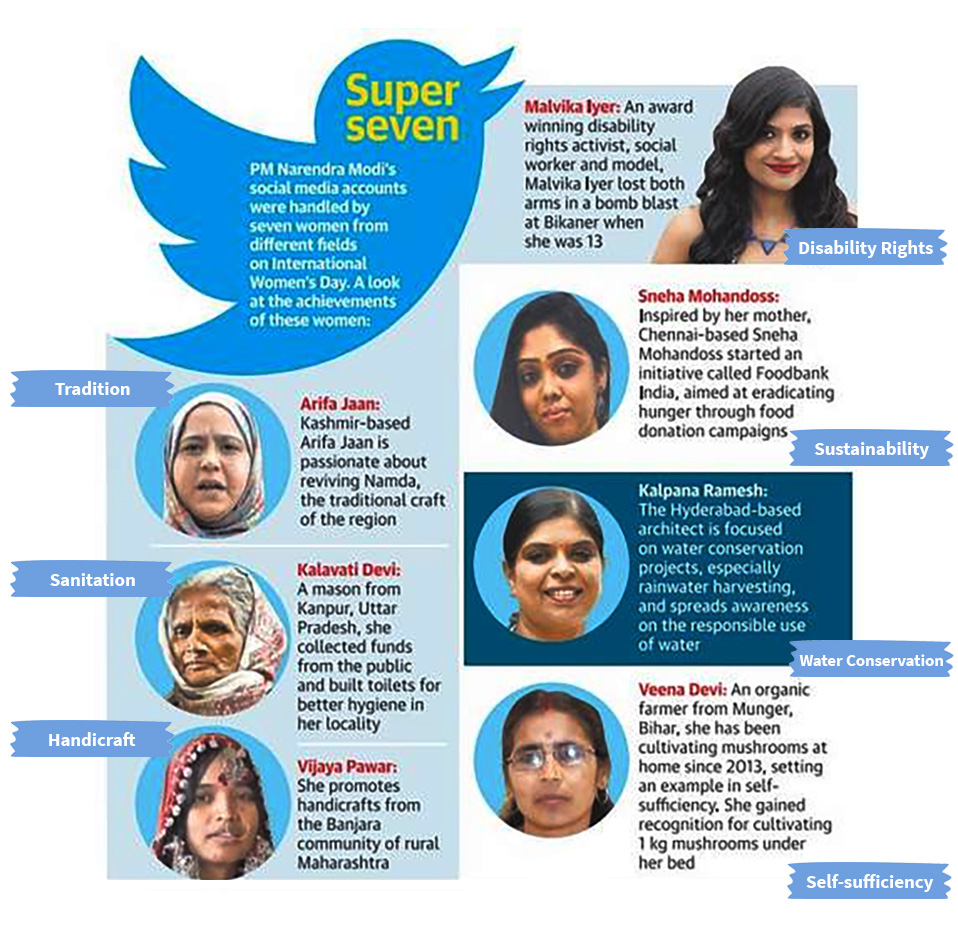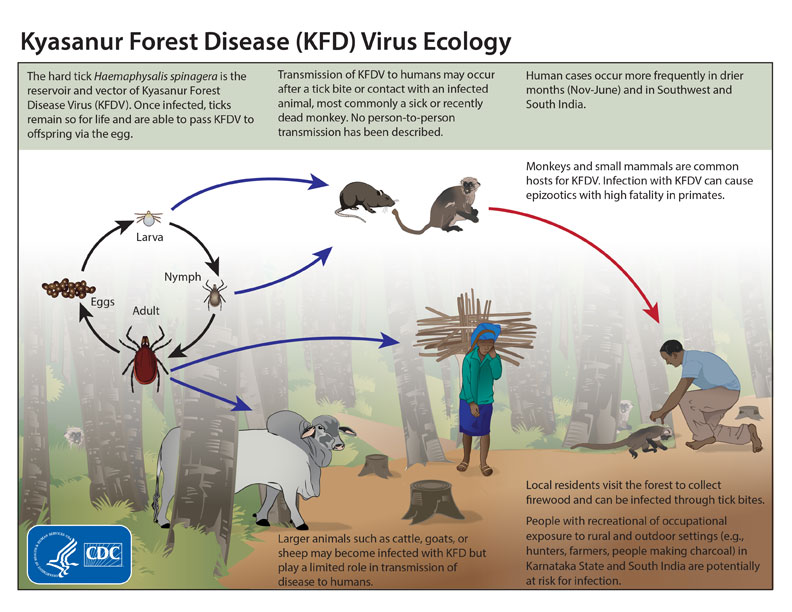Important Facts For Prelims
KIRAN Scheme
Why in News
The Knowledge Involvement in Research Advancement through Nurturing (KIRAN) Scheme is one of the several pioneering initiatives started by the Department of Science and Technology (DST) for promoting women in science.
Key Points
- The Department of Science and Technology (DST) is implementing ‘Knowledge Involvement in Research Advancement through Nurturing (KIRAN)’ Scheme to provide various career opportunities to women scientists and technologists.
- It is primarily aimed to bring gender parity in the Science & Technology sector by inducting more women talent in the research & development domain through various programmes.
- It also provides fellowship support ranging from Rs 25000 to 55000 to women ranging in the age group 27 to 57 years for continuing higher education in Science and Technology after a break in career.
Governance
Unutilised Budgetary Funds in Education
Why in News
Recently, the Parliamentary Standing Committee on Human Resource Development (HRD) has presented a report on the 2020-2021 demand for grants for school education in the Rajya Sabha.
- The report identifies shortfalls in budgetary funding and utilisation, resulting in critical infrastructure gaps in the government schools in India.
Key Points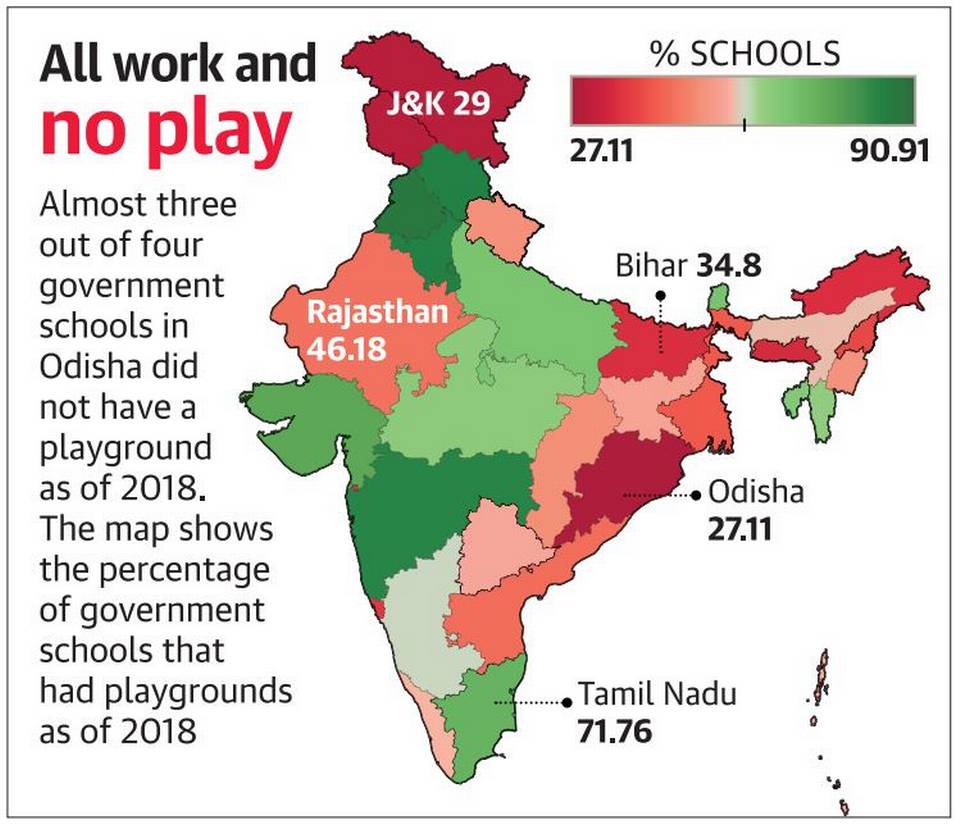
- Reduction in Finance:
- The budgetary allocations experienced a 27% cut from proposals made by the School Education department.
- Similarly, 27% of reductions have been observed in the fund needed for the implementation of Central and Centrally Sponsored Schemes.
- Also, the government has spent only 71% of allotted funds for the core Samagra Shiksha Scheme until December 31, 2019.
- Access to Electricity and Playground:
- Almost half of the government schools in the country do not have any electricity or playgrounds.
- Only 56% of schools have electricity, with the lowest rates in Manipur and Madhya Pradesh, where less than 20% have access to power.
- Less than 57% of schools have playgrounds, including less than 30% of schools in Odisha and Jammu and Kashmir.
- Overall Infrastructure:
- A dismal rate of progress has been observed in building classrooms, labs and libraries to strengthen government higher secondary schools.
- Almost 40% of schools did not have a boundary wall, endangering the safety of students and school property.
- The higher secondary schools experienced greater infrastructural gaps compared to secondary schools and primary schools.
- Also, less than 5% of proposed infrastructure facilities such as ramps and special toilets for differently-abled students have been completed in the government schools.
Recommendations
- Additional funds for implementation of the core schemes such as Samgra Shiksha Abhiyan.
- Collaboration of HRD Ministry with the Mahatma Gandhi National Rural Employment Guarantee Scheme (MGNREGS) to construct boundary walls and other infrastructure facilities.
- Collaboration with the Ministry of New and Renewable Energy to provide solar energy and other renewable energy sources so that schools have access to power.
Science & Technology
Commercial Cord Blood Banking
Why in News
- Recently there has been growing concern regarding the aggressively promoted concept of cord blood banking.
Key Points
- Over the past decade, stem cell banking has been aggressively marketed even as its use is still in experimental stages.
- The stem cell banking companies get access to data of to-be parents and start approaching their prospective customers much before the delivery and offer competitive packages.
- Companies convince parents to bank the cells for several years promising future therapeutic use.
- Enormous fees are charged from parents to preserve cells merely by emotional marketing.
- However, according to Indian Council of Medical Research (ICMR), there is no scientific basis for preservation of cord blood for future self use and this practice therefore raises ethical and social concerns.
- The ICMR does not recommend commercial stem cell banking.
- Private storage of the cord blood is advisable when there is an elder child in the family with a condition treatable with these cells and the mother is expecting the next baby.
- In other situations, parents should be educated about the limitations of banking at this point of time.
Cord Blood Banking
- Cord blood is the blood from the baby that is left in the umbilical cord and placenta after birth. Cord blood banking involves taking the umbilical cord blood, which is a rich source of stem cells, and preserving it for future use.
- It contains special cells called hematopoietic stem cells that can be used to treat some types of diseases.
- Hematopoietic stem cells can mature into different types of blood cells in the body.
- Globally, cord blood banking is recommended as a source of hematopoietic stem cell (derived from bone marrow, peripheral blood, or umbilical cord blood) transplantation for haematological cancers and disorders where its use is recommended.
- For all other conditions, the use of cord blood as a source of stem cells is not yet established.
Stem Cells
- Stem cells are special human cells that have the ability to develop into many different cell types, from muscle cells to brain cells.
- Stem cells are divided into two main forms- Embryonic stem cells and Adult Stem Cells.
- Embryonic stem cells come from unused embryos resulting from an in vitro fertilization procedure and that are donated to science.
- These embryonic stem cells are pluripotent, meaning that they can turn into more than one type of cell.
- Adult Stem Cells: There are two types of adult stem cells.
- One type comes from fully developed tissues, like the brain, skin, and bone marrow.
- There are only small numbers of stem cells in these tissues, and they are more likely to generate only certain types of cells.
- For example, a stem cell derived from the liver will only generate more liver cells.
- The second type is induced pluripotent stem cells.
- These are adult stem cells that have been manipulated in a laboratory to take on the pluripotent characteristics of embryonic stem cells.
- One type comes from fully developed tissues, like the brain, skin, and bone marrow.
Indian Council of Medical Research
- ICMR is the apex body in India for formulation, coordination and promotion of biomedical research.
- Its mandate is to conduct, coordinate and implement medical research for the benefit of the Society; translating medical innovations into products/processes and introducing them into the public health system.
- it is funded by the Government of India through the Department of Health Research, Ministry of Health & Family Welfare.
Social Justice
National Conference on Women in Police and CAPFs
Why in News
- Bureau of Police Research and Development (BPR&D) organised the National Conference on Women in Police and Central Armed Police Forces (CAPFs) in New Delhi.
- It was inaugurated by the Union Minister for Women And Child Development.
Key Points
- The main objective of the National Conference was to discuss and deliberate on the following two themes:
- Cyber Stalking and Bullying of Women: Steps for Protection
- Challenges faced by CAPF Women in Operational Areas
- Few important issues related to women in Police which were highlighted during the conference are:
- Workplace harassment besides cyber crime.
- Society should not look at the working women with bias and hold the performance of men to be the only benchmark for success.
- Training of members of the Child Welfare Committees (CWC).
- The need to train more female forensic investigators and cyber crime experts.
- BPR&D was also advised to make an SoP for “One Stop Centre for Women”.
- To commemorate this event, a hand-out – “BPR&D Mirror – Gender Benders” was released, which stated the recent initiatives taken by BPR&D to promote Woman Safety.
Bureau of Police Research and Development (BPR&D)
- The Government of India established the Bureau of Police Research and Development (BPR&D), under the Ministry of Home Affairs in the 1970s.
- It replaced the Police Research and Advisory Council (1966), with the primary objective of modernization of police force.
- In 1995 Government of India decided to entrust issues relating to Correctional Administration Work to the BPR&D.
- Thereby BPR&D has to ensure the implementation of prison reforms as well.
- The Government of India further decided to create a National Police Mission under the administrative control of BPR&D to transform the police forces in the country.
- Recently, BPR&D observed its 50th foundation day.
Child Welfare Committees (CWC)
- The Child Welfare Committee (CWC) is constituted under the Juvenile Justice (Care and Protection of Children) Act, 2015. It is the sole authority to deal with matters concerning children in need of care and protection.
- The Committee is constituted for each district or group of districts.
Biodiversity & Environment
Illegal Trade of Red Panda
Why in News
The trade monitoring network TRAFFIC has released a report titled “Assessment of illegal trade-related threats to Red Panda in India and selected neighbouring range countries” recently.
- The report has analysed poaching and illegal trade of the species for the ten-year period from July 2010 to June 2019.
Key Findings
- The red panda survival is crucial for the eastern and north-eastern Himalayan subalpine conifer forests and the eastern Himalayan broadleaf forests.
- The animal has been hunted for meat and fur, besides illegal capture for the pet trade.
- An estimated 14,500 animals are left in the wild across Nepal, Bhutan, India, China and Myanmar.
- The report has indicated that the traditional demand for red panda meat and related products has reduced over time.
- Also, the reduction in poaching and illegal trade of red panda is indicative of the success of awareness campaigns about the conservation of the species.
Recommendations
- Community-based conservation and protection for the species as its habitat stretches across remote areas.
- Trans-boundary law enforcement co-operation through the use of multi-government platforms like SAWEN (South Asia Wildlife Enforcement Network).
- SAWEN was formally established at an inter-governmental meeting hosted in Paro (a town in Bhutan) by the Royal Government of Bhutan, in January 2011.
- It aims to establish multilateral collaboration to fight wildlife crime in the region.
Red Panda
- The red panda is a small reddish-brown arboreal mammal.
- The only living member of the genus Ailurus.
- It is also the state animal of Sikkim.
- It is listed as Endangered in the IUCN red list of Threatened Species and under Schedule I of the Indian Wildlife (Protection) Act, 1972.
- It is found in the forests of India, Nepal, Bhutan and the northern mountains of Myanmar and southern China.
- It thrives best at 2,200-4,800m, in mixed deciduous and conifer forests with dense understories of bamboo.
- In India, About 5,000-6,000 red pandas are estimated to be present in Sikkim, western Arunachal Pradesh, Darjeeling district of West Bengal and parts of Meghalaya.
- This is the second-largest population after China (6,000-7,000).
- Red pandas have been reported from 11 districts of Arunachal Pradesh, which is presumed to hold the largest red panda population in the country.
TRAFFIC – The Wildlife Trade Monitoring Network
- TRAFFIC is a leading non-governmental organisation working globally on trade in wild animals and plants in the context of both biodiversity conservation and sustainable development.
- It is a joint program of WWF and IUCN – the International Union for Conservation of Nature created in 1976.
- TRAFFIC focuses on leveraging resources, expertise and awareness of the latest globally urgent species trade issues such as tiger parts, elephant ivory and rhino horn.
Important Facts For Prelims
Super Seven
Why in News
Prime Minister of India on 8th March 2020 marked International Women’s Day by handing over control of his social media accounts to seven women achievers.
Key Points
- Namda Traditional Art
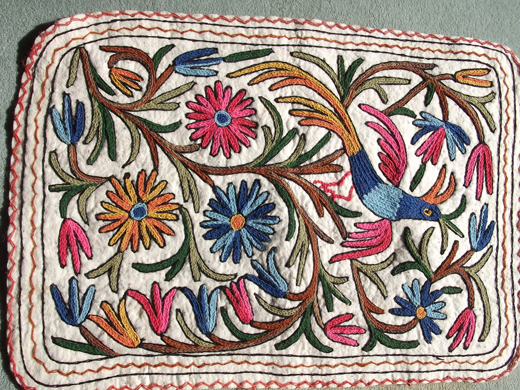
- Namda is a local term used for traditional felted wool floor coverings, made out of a coarse variety of wool.
- Namda comes from the root word Namata (Sanskrit for woollen stuff).
- Namda making is practised as a craft in several cultures, especially in the countries throughout Asia, viz. Iran, Afghanistan and India.
- Srinagar in Kashmir and Tonk in Rajasthan are the two major namda making centres in India.
- In India, it is known to have come from Iran and was actively promoted in the state under the patronage of the Mughal monarchs and the Rajput royals.
- Rich hues and exquisite designing are the hallmarks of the handcrafted Namda.
- Unique themes and floral patterns provide the themes for these masterpieces and flowers and leaves, buds and fruits are the essence of the designs.
- Namda is a local term used for traditional felted wool floor coverings, made out of a coarse variety of wool.
- Banjara Community
- The word ‘banjara’ is derived from Vanaj meaning to trade, and Jara meaning to travel.
- Banjara (sometimes called Gypsies) is a nomadic tribe of India and were the vital supply chain for villages.
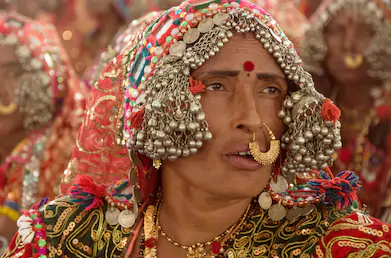
- They were commercial nomads, that is, hundreds of years ago they distributed salt and other essential items to interior villages, but they did have a connection with the land.
- The Banjaras were among many tribes that resisted the British attempt to seize their lands for plantations and enrol them as labour.
- Their constant revolt frustrated the British, and in 1871, the Banjaras and several other tribes were brought under the Criminal Tribes Act.
- The community was denotified in the 1950s but were listed under the Habitual Offenders Act, 1952.
- With roots in Rajasthan, Banjaras now live in several states and are known by different names like Lambada or Lambadi in Andhra Pradesh, Lambani in Karnataka; Gwar or Gwaraiya in Rajasthan etc.
- They are listed in various States as Scheduled Caste (SC), Scheduled Tribe (ST), Other Backward Class (OBC) and as Vimukta Jati/denotified tribes.
- The language of Banjara is known as “Gorboli” “Gor mati Boli” or “Brinjari” an independent dialect.
- The dialect falls in the category of Indo-Aryan language.
- Foodbank India
- The India Food Banking Network (IFBN) is evolving an ecosystem for food security interventions to support thousands of feeding programmes in India by bringing the government, private sector and NGOs together to fight hunger and malnutrition in India.
- Vision: To have a hunger and malnutrition free India which falls in line with the Sustainable Development Goals (SDG 2- Zero Hunger by 2030).
- It aims to achieve the vision by establishing a strong and efficient network of FoodBanks throughout the country so that every district has access to at least one FoodBank by 2030.
- It is a multi-stakeholder partnership of global, domestic and local community partners who contribute voluntarily to support the humanitarian and development projects.
Important Facts For Prelims
Conference on Empowering Women Entrepreneurs 2020
Why in News
The Conference on Empowering Women Entrepreneurs 2020 has been inaugurated on the occasion of the International Women’s Day (8th March) in New Delhi.
Key Points
- The three-day conference has been organised by the Ministry of MSME in collaboration with various industry associations like FICCI-flo, CII and India SME Forum.
- Also, a discussion on ‘Creating a conducive business Eco System for Empowering Women Entrepreneurs’ has been arranged for more than 300 women entrepreneurs from all parts of the country.
- The conference mentioned MSME Sambandh and Udyam Sakhi portal which has helped to generate a pool of successful women entrepreneurs in the country.
- MSME Sambandh aims to monitor the implementation of public procurement from MSMEs by Central Public Sector Enterprises.
- Udyam Sakhi portal intends to provide the right information for women entrepreneurs about self-employment on one single portal.
Important Facts For Prelims
Warli Adivasi Revolt
- In 1945, it began in Zari village, Talasari taluka (Maharashtra).
- Affected from the exploitation from the landlords and money-lenders, nearly 5,000 indentured tribals gathered and refused to work on landlords’ fields until they received 12 annas a day in wages.
- Their resistance sowed the first seeds of rights-based movements among the region’s indigenous communities.
- Women played an important role in the revolt and helped the men in all possible aspects.
- The involvement of the women was supported by the Kisan Sabha leader, Godaveri Parulekar, also known as Godutai (elder sister) by the Adivasis.
- Women followed her and spoke at meetings about the oppression they faced and encouraged other women to join the struggle.
Warli Tribe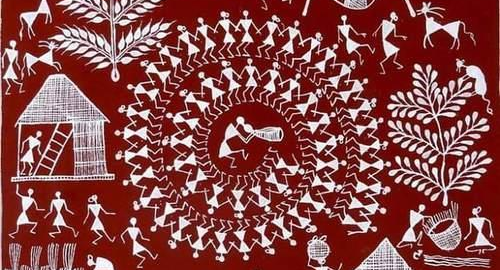
- They are spread across Thane, Nashik and Dhule districts of Maharashtra, Valsad district of Gujarat, Karnataka, Goa and the Union Territories of Dadra & Nagar Haveli and Daman & Diu.
- They are small-scale cultivators and cultivate rice, pulses and vegetables. They also sell toddy, mahua and fuelwood to their tribesmen and neighbouring communities for a living.
- Warli are nature worshippers.
- Warli art stems from their belief system shaped by their centuries-old subsistence on forest land.
- They did not have a written word until recent times and their art was a way of transmitting their belief systems from one generation to the next.
- Their drawings revolve around community traditions, the tools they use and their association with nature.
Important Facts For Prelims
Kyasanur Forest Disease
Why in News
- There is a proposal to set up a research centre on Kyasanur Forest Disease (KFD) in Sagar, Karnataka.
- The State government has already allocated ₹15 crore for establishing the centre, which will take up study and research on tackling KFD.
Key Points
- It is caused by Kyasanur Forest disease Virus (KFDV), a member of the virus family Flaviviridae.
- It was first identified in 1957 in a sick monkey from the Kyasanur Forest in Karnataka. Since then, between 400-500 human cases per year have been reported.
- KFD is endemic to the Indian state of Karnataka. It is also referred to as monkey fever by locals.
- Rodents, shrews, and monkeys are common hosts for KFDV after being bitten by infected Hard ticks (Haemaphysalis Spinigera). KFDV can cause epizootics (outbreak of disease in animals) with high fatality in primates.
- Transmission: To humans, it may occur after a tick bite or contact with an infected animal (a sick or recently dead monkey).
- Signs and Symptoms: After an incubation period of 3-8 days, the symptoms like chills, fever, headache, severe muscle pain, vomiting, gastrointestinal symptoms and bleeding may occur. Patients may experience abnormally low blood pressure, and low platelet, red blood cell, and white blood cell counts.
- Diagnosis: It can be diagnosed in the early stage of illness by molecular detection by Polymerase Chain Reaction (PCR) or virus isolation from blood. Later, serologic testing using enzyme-linked immunosorbent serologic assay (ELISA) can be performed.
- Treatment and Prevention: There is no specific treatment for KFD although vaccine is available.

